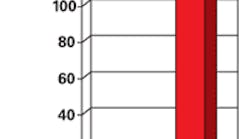by Bill Landers
[email protected]
Ever wondered how many bacteria are in the mouth? Or how fast they multiply?
Nobody knows for sure. We don’t even know exactly how many species there are, let alone how to count them or how fast they grow. Estimates of the number of bacterial species in the oral cavity vary between 500 to 650 different species. They live on the teeth and tongue, of course, but biofilms also cover the cheeks and oral mucosa.
One scientist, Dr. Walter Loesche from the University of Michigan, conceived an elegant method of estimating both the total number of oral microbes and how fast they grow. He outlines the method in his book, “Caries, A Treatable Infection.”
How many?
We do know a few facts. Researchers (very patient researchers) have painstakingly harvested all the plaque from every surface of every tooth. It weighs, on average, about 10 mg. But the teeth only comprise 1/20 of all the oral surfaces. You have to multiply the 10 mg from the teeth by 20 to get the total biomass including cheeks, tongue, etc.
We also know that 1 mg of oral biomass typically contains about 100 million microbes. By multiplying the number of microbes in 1 mg by 20, we get the total number of microbes in the entire oral cavity.
100 million microbes x 20 mg biomass = 20 billion oral microbes.
How fast?
We know that some species of oral bacteria can double their numbers every 20 minutes under ideal conditions in a Petri dish. In the mouth, though, species have to compete with each other, and conditions are not always as idyllic as in the lab. For instance, some people actually inhibit bacterial growth by brushing their teeth and tongue!
So, how does one calculate the in vivo growth rate of oral bacteria if it can’t be measured in vivo? Dr. Loesche showed that one could calculate it indirectly from two other known facts. We know that the average person swallows about 1 liter (1,000 milliliters) of saliva daily. We also know that 1 ml. of saliva contains about 100 million microbes. Multiplying 1,000 ml of saliva by 100 million (microbes per ml.) gives us 100 billion. That’s the number of microbes in the saliva we swallow every 24 hours.
Lastly, and this is Dr. Loesche’s great insight, almost all of those billions of microbes that we swallow began their lives in an oral biofilm. Thus, despite only having (at any given time) 20 billion microbes in our mouths, we nevertheless swallow 100 billion! Five times more than we have. So, those 20 billion microbes in our mouths must be producing and shedding 100 billion additional microbes every day. That’s five times their original number. Said another way, they are doubling their numbers five times every 24 hours. Dividing 24 hours by 5 = 4.8 hours, the amount of time it takes for the microbes in our mouths to double their number.
Those calculations are based on average numbers. The actual numbers may be even higher. We can’t identify all the bacterial species, for example, so we’re probably undercounting some. The average reproductive rate may be faster too. Some newly-made bacteria must die before they can be shed as daughter cells into the saliva.
Whatever the actual number might be, it’s huge with a rapid growth rate. Fast enough to impress even the most casual brusher. If your patients aren’t brushing regularly, try motivating them with some facts. “There are 20 billion bacteria in your mouth and they reproduce every five hours. If you go 24 hours without brushing, those 20 billion become 100 billion!”
About the Author
Bill Landers has been president of OraTec Corp. since 1992. He is also a leading expert on chairside and laboratory periodontal risk assessment technologies, and his essays on periodontal disease have been published in several dental hygiene journals. Landers has presented hundreds of continuing education seminars on the microbiology of periodontal diseases.







